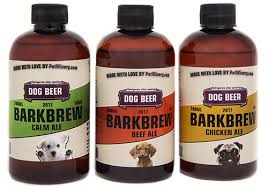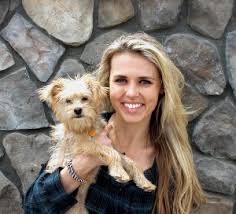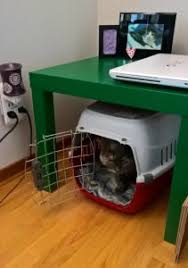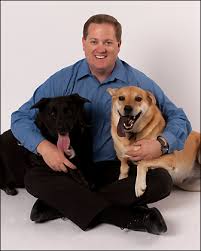Cocktails For Your Pets
Taryn Nahm, Pet Winery
 Taryn Nahm wants you to kick back a few cocktails with your pet. She says you can bond with your pet while you relax with a beverage. Taryn created pet cocktails that look just like the human adult versions, except without alcohol.
Taryn Nahm wants you to kick back a few cocktails with your pet. She says you can bond with your pet while you relax with a beverage. Taryn created pet cocktails that look just like the human adult versions, except without alcohol.
Taryn Nahm is the brainchild behind the Pet Winery. She created a complete line of Pet Beverages for your pets to enjoy with you! From Tea to Champagne, Wine and Martinis, they have you covered! All Non-alcoholic and a healthy treats! Cheers to the Canines and the Felines!
Some of the feline wines contain salmon oil and a little organic catnip, while the dog wines contain bacon extract. They even have champagne for your dog (Dog Pawgrignon) and for your cat (Meow & Chandon) as well as Dogtini and Cattini. There is no alcohol in any of their pet drinks; they are just fun drinks for your pet that are completely healthy for them as well.
The Pet Winery started out with wine after Taryn saw pet wines on the market. She already had a lab and didn't like some of the ingredients in the other stuff that was out there, so she formulated her own complete line of wines for pets. With her being a huge gin drinker, she decided that they also needed some martinis and maybe some champagne.
Taryn says it's all in good fun and she sees that people are humanizing their pets, just like she does with her cat at home, who is a part of the family. So if Taryn is drinking a glass of wine or a gin and tonic, she might as well have her beloved cat Sadie drink one with her.
 The humans taste test the products in the lab before using their own pets, as well as friend's pets, to make sure the pets are going to like it. So you could actually say that their products were safely tested on humans before they gave it to any pets.
The humans taste test the products in the lab before using their own pets, as well as friend's pets, to make sure the pets are going to like it. So you could actually say that their products were safely tested on humans before they gave it to any pets.
But they didn't forget about beer for the dogs. They figured that a man's best friend also needed a brewski to go along with them. So for man's best friend, they came out with Barkbrew in a couple different varieties.
There are other companies that are making pet wines, but what Taryn states is unique about the Pet Winery, is that they tried to mimic the human beverages in their bottles as much as they could. So all the bottles look different in accordance to what the human beverages are.
Visit Website
Fear Free Tips You Can Use
Mikkel Becker, Lead Trainer for Fear Free Pets
 Do you have trouble getting your pet to the vet? You're not alone. Certified Trainer Mikkel Becker has some great ideas for making vet visits easy and enjoyable. Check out our Fear Free Expert Series.
Do you have trouble getting your pet to the vet? You're not alone. Certified Trainer Mikkel Becker has some great ideas for making vet visits easy and enjoyable. Check out our Fear Free Expert Series.
Mikkel Becker has a few certifications as a dog behavior counselor as well as being a Karen Pryor Certified Training Partner. She also has certifications through different dog training organizations like the Association of Pet Dog Trainers as both a behavior counselor and a dog trainer. Mikkel says she has been very blessed to be able to have that kind of educational experience. She states it's just something where she feels like you can never learn enough and that there's just so much to learn.
Even with all of these certifications, Mikkel says the biggest and most important certification that she has is the Fear Free Certification.
The Fear Free Movement is making veterinary care more like pediatric dentistry or pediatric medicine. This has changed so much from when we were younger and many of us were manhandled and manipulated, threatened and abused. Now, these offices are geared towards children to make them comfortable and relaxed to where they actually enjoy going. This is what they are trying to do for our pets.
So how do you get a fearful pet to the vet? This is a big hurdle for lots of people. Mikkel claims that there's not just one way that is a quick fix. It really depends upon the animal in figuring out what it is that's distressing for them.
For some animals, especially for cats, it's the carrier. The carrier itself is very concerning and we need to make it more comforting to the animal. You should always leave it out, along with your other furniture, or what Mikkel calls "purr-niture." You know how it goes, we take the carrier out from the closet and the cat knows exactly what is going to happen. They then run and hide.
 To make the carrier more comfortable for your cat, you can make it their regular bed, the place that they like to hang out in. You may also want to put some surprises in the carrier. You can have little Hansel and Gretel type treat trails or toy type trails leading into it or even catnip. You want your cat to want to go inside. You can also almost make it like a cardboard box. Cats love boxes and they love to hide and love to feel secure where they have comfort on all sides. You can actually use that natural tendency in the way of getting them more comfortable with their carrier before you actually have to use it.
To make the carrier more comfortable for your cat, you can make it their regular bed, the place that they like to hang out in. You may also want to put some surprises in the carrier. You can have little Hansel and Gretel type treat trails or toy type trails leading into it or even catnip. You want your cat to want to go inside. You can also almost make it like a cardboard box. Cats love boxes and they love to hide and love to feel secure where they have comfort on all sides. You can actually use that natural tendency in the way of getting them more comfortable with their carrier before you actually have to use it.
Many veterinarians are now Fear Free Certified. One method to teach veterinarians to be Fear Free is for them to observe an animal's body language and figuring out how stressed they are. And of course, those animals are not going to be as comfortable in a lot of situations, like during a procedure, as they may be at home crashed out on the couch where they're just super relaxed. Maybe they won't get to that degree of relaxation, but what we really want to see is that pet in a really comfortable state. So we don't want to see any elevated degree of stress. And if we do see that, what we do is attend to those signs and try and get the animal to feel more comfortable.
This might be working with them in a way that they are most comfortable with. So rather than invading their space, for instance, or going right up to a dog that might be hiding underneath the chair, its seeing if there's a way that we can get the dog to come out on their own. It also involves actually setting up areas that an animal will naturally just gravitate to. For instance, for cats we may even have a slightly warm towel that is placed on the counter. That can be really helpful. So what we do is we just attend to their emotional state, as there are different levels of fear, anxiety and stress.
What are some simple methods of gentle control that we can use as pet owners?
Mikkel states that one of the biggest ones is in how we pet our pets. Sometimes it's a big surprise when all a sudden a hand reaches out and touches an animal. Have you ever noticed that when you go to pet your dog or your cat, if they don't know you're coming, it can be like "whoa" and they might jump back? One thing that we can do is to give them a cue to tell them that we're going to pet them. Sometimes she uses the word "pet." She will then start off in an area where the animal is comfortable.
For cats, she will usually go towards their cheek area and put her hand out and let them naturally rub into her hand or start in a more neutral area such as right behind their ears.

For a dog, that neutral area is usually around the chest area or the side of their shoulder. Once we have initiated that first touch, and a lot of times we're giving treats with it to make it positive, then we can start to slide to those other areas that we want to handle.
So rather than just immediately going for your dog's paws or your cat's paws for a nail trim, instead what you can do is to use a key word such as "pet" and start in that comfortable area where the animal is okay being touched. You can then slide down to the other area versus pulling your hands off and them putting them back on the animal again. You should think of it like a massage, where the masseuse keeps one hand on you as they do the massage. This makes it less of a surprise when they move, because you have an idea of where they're going. This is just like how you would handle and walk around a horse. You keep your hand on them and we can do the same exact thing with our dogs and cats. It's very helpful, less of a surprise, more predictable and we can make it a positive experience for them.
Mikkel Becker (CBCC-KA, KPA CTP, CDBC, CPDT-KA, CTC) is the lead trainer for Fear Free Pets. She is a certified behavior consultant and certified trainer who specializes in work with dogs and cats. Mikkel is the co-author of six books, including "From Fearful to Fear Free." In her professional work, Becker uses positive reinforcement and non-force based training strategies that are rooted in scientific learning theory. Mikkel is committed to helping pets and their people live better lives together through motivational, reward-based training that's closely partnered with the pet's veterinary team.
Check out the websites Fear Free Happy Homes and Fear Free Pets.
Listen and Explore the Fear Free Expert Series
Dogs Get The Flu Too - Canine Influenza - Dr. Debbie

Can you give your dog the flu, or catch it from him? No way. But dogs can become infected with their own strain of canine influenza. With much attention on the tough human flu season, it's a good time to talk about the differences, and similarities, between human and canine influenza.
What is Dog Flu?
Canine Influenza, also known as H3N8, was identified in 2004. The disease mutated from a strain of the equine influenza virus and was first detected in racing greyhounds. Canine influenza has unfortunately migrated across the country.
Although the human flu peaks in winter seasons, canine influenza doesn't show seasonality; rather dogs can acquire canine influenza all year round.
The Illness
A dog sick with canine influenza develops respiratory infection signs similar to kennel cough that last three to four weeks. Symptoms include coughing, gagging, sneezing, runny nose and high fevers up to 104-106 degrees. Normal dog temperature ranges 101-102 degrees Fahrenheit.
Most dogs infected with canine influenza will get sick and recover. But like the human flu, fatalities can occur. Approximately 5-percent of canine influenza infected dogs may die, usually to secondary pneumonia. Older pets, pups, or those with chronic illness are more likely to develop pneumonia than the average healthy dog.
There isn't a specific treatment for dogs infected with canine influenza, but most dogs recover with supportive care including good nutrition, rest and maintaining adequate hydration. Severely ill pets with secondary bacterial pneumonia may be hospitalized and treated with IV fluids and antibiotics.
 Dog Flu Transmission
Dog Flu Transmission
Dog flu is similar to human flu in that it is spread by aerosol transmission as well as through contact with contaminated items. Since dogs don't cover their cough or sneezes, the virus is easily carried through respiratory droplets to other dogs and items in the immediate area. Any place that canines frequent, or spend time around, can become contaminated by infected dogs - that includes water bowls, surfaces and even human hands.
What do you do if you notice your dog's play pal is coughing, sneezing and has a runny nose? Separate your dog immediately and closely monitor your dog for symptoms for 7 days - the time it takes for symptoms to appear after exposure to the virus. If symptoms develop, call your veterinarian.
Past that timeline and you are probably fine. But don't forget that 10 to 20-percent of infected dogs will shed the virus, but never show any symptoms of illness. These apparently healthy carriers can go on and spread the infection to other dogs without ever becoming ill.
Vaccination and Prevention Steps
A vaccine was created, but just like the human flu vaccine, it doesn't guarantee your dog CAN'T get sick. However the vaccine is helpful in decreasing the severity of infection and decreasing the spread of virus.
Vaccination for canine influenza isn't recommended for every dog at this time. Lifestyle and geographic location influence an individual dog's risk of acquiring canine influenza. Dogs that frequent high-density dog areas are at increased risk of canine influenza and are candidates for vaccination. So if your dog goes to areas like the dog park, trainer, groomer or boarding facility, ask your veterinarian if vaccination is a good idea.
Don't think you have to keep your dog locked in the house forever to hide from canine influenza. For most dogs, the risk of contracting canine influenza is quite small. Good sense and preventative steps are useful to avoid dog illness. These include quarantining new or sick dogs, using good hygiene through disinfection and hand washing and avoiding unnecessary contact with suspected infected dogs, especially if your dog is young, old, or has a compromised immune system.
What Should Pet Owners Do?
Flu awareness and preparedness makes good sense - for both people and pets. But remember that there are other causes of canine respiratory disease. So just because you hear a cough doesn't mean your dog has the flu. Ask your veterinarian about your pet's individualized risks for acquiring canine influenza.
Featured veterinarian known as "Dr. Debbie" on national pet radio program, Animal Radio. Ebook author of "Yorkshire Terriers: How to Be Your Dog's Best Friend"; "Pugs: How to Be Your Dog's Best Friend"; "Mini Schnauzers: How to Be Your Dog's Best Friend"; and "Shih Tzu: How to Be Your Dog's Best Friend." Dr. Debbie's books.
Visit Website
The Biggest Reason Your Pet May Be Obese
Robert Semrow, Listomania
 I know that we've all heard about the pet obesity epidemic by know. It's scary to think that numbers continue to grow each year. Nearly 60-percent of cats and 56-percent of dogs are considered overweight or obese. This probably shouldn't surprise us, but it does. It's a problem that has to be addressed because of its overwhelming negative ramifications for our beloved pets.
I know that we've all heard about the pet obesity epidemic by know. It's scary to think that numbers continue to grow each year. Nearly 60-percent of cats and 56-percent of dogs are considered overweight or obese. This probably shouldn't surprise us, but it does. It's a problem that has to be addressed because of its overwhelming negative ramifications for our beloved pets.
Some of the many issues that arise from overweight and obese pets include reduced life spans, reduced quality of life, chronic inflammation, orthopedic disease, kidney dysfunction, cancers and much more. In fact, we are seeing illnesses most pet parents are surprised to hear pets can have including pet diabetes, high blood pressure and more. If you think about asking the body to overwork itself everyday, it's easy to understand that every extra pound has much more concerning consequences.
So how do you know if your pet is overweight or obese? For dog's and cats there are some easy signs to see if you are observant. For dogs, you should be able to see and feel the outline of your dog's ribs without excess fat covering them. For cat's you should be able to see and feel your cat's ribs, spine and hipbones without much pressure. From above your dog or cat, you should be able to see their waist clearly defined and from below you should not see sagging.
There are many factors as to why your pet might be overweight or obese. They include the pet's natural factors like genetics, breed, sex, age and whether they have been neutered. These can all have a huge impact on your pet's potential for obesity.

Then there is the biggest reason your pet may be obese, and I know we don't want to hear it but it's true, the biggest reason your pet may be obese is you. From food choices to the amount of food and treats to exercise habits and more, an undeniable cause for pet obesity is their owners. It's heartbreaking to admit, because more times than not it's done out of love or just not knowing. Still, this is the health of a living being we are talking about. Our pets don't go shopping at the store or drive through fast places for a quick meal. No it's us. And we can, and have to, do better for the sake of our pets. We can greatly impact the health and well-being of our pets with better nutrition, better exercise and better understanding.
So take a minute for the sake of your beloved pet and assess what stage your pet is at. Are they overweight or obese? If so, think about how you can improve their health, the same way you would improve your own. Start with nutrition, then exercise habits and figure out what you can do that is sustainable. I can't stress it enough; whatever you do must be sustainable. Doing something for a week or two isn't enough.
If you're not sure where to start, look for a pet nutritionist, pet exercise group and other resources who are out there and only too happy to help you get your pet in better shape.
Don't be the biggest reason that your pet is obese, be the biggest reason that your pet lives a long healthy, happy and fulfilling life.
Share your ways to a healthy pet stories on our Animal Radio Facebook Page.
Visit Website
Animal Radio News - Lori Brooks
 Millennials Are Changing The World of Pets
Millennials Are Changing The World of Pets
Millennials, or Generation Y, are those born between 1982 and 2004 and they are quickly changing the world of pets. There's lots of new research out on millennials and their pets because they are the ones driving all this change. Here's some of the latest. Our pet dogs are getting bigger! Fifty-percent of millennials owned a medium-sized dog compared with 34-percent of older owners. Pet ownership is becoming more balanced between men and women. More millennial dog owners are male (39-percent) compared with older dog owners (29-percent) and more millennial cat owners are male (46-percent) compared with older cat owners. Millennials are now the largest segment of pet owners. They found Millennials invest more time in their pets, evaluating their needs more thoroughly and spending more money. They are also more likely to use products continuously versus intermittently.
Pets Are Moving Into the Area of Dating Sites
Pet lovers want to be in relationships with other pet lovers, as our pets are now included in almost every aspect of our lives. Purrfect Date is a six-chapter visual, novel, dating simulator and dark British comedy all in one game for cat lovers! Your role is to play the human who has been hired to conduct research on the mysterious Cat Island, alongside the eccentric Profession Pawpur. It turns out the cats on the island can speak and are in need of your help. Now here's the twist. There are six cats you can date in this experience. As one reviewer said, the cat date was not as creepy as she thought, and it's not sexual, but more about building an intimate relationship.
 Group Named "CATS" Has A Cat
Group Named "CATS" Has A Cat
You wouldn't expect a group named CATS to be for dogs, but in this case CATS stands for Canine Airport Therapy Squad, a group of therapy animals at Denver International Airport. But they really do have a cat. The original therapy dogs were joined by a therapy feline. Xeli joined more than 80 dogs representing nearly 40 breeds on the CATS squad.
If Your Pet Is Unwell - You Might Be Unwell Too
Research shows that if your pet is unwell, it can make you unwell, leading to depression, anxiety and a poorer quality of life. It's the same problem that was previously found in the human world. It's known as Caregiver Burnout or Caregiver Burden. Researchers at Kent State University in Ohio compared the results of 119 owners of sick dogs or cats with the same number of owners of healthy pets. They found that those with a chronically or terminally ill pet showed greater caregiver burden compared to those with a healthy pet. It's hoped the findings will help veterinarians understand and more effectively handle pet parents stress when caring for a sick pet.
 Listen to the entire Podcast of this show (#1241)
Listen to the entire Podcast of this show (#1241)





